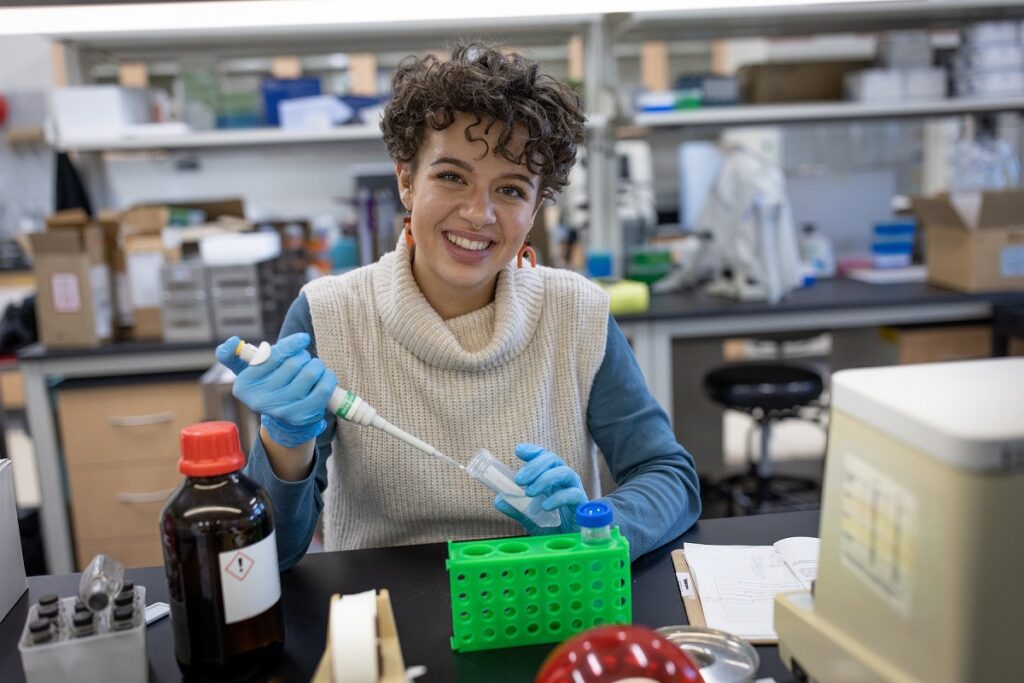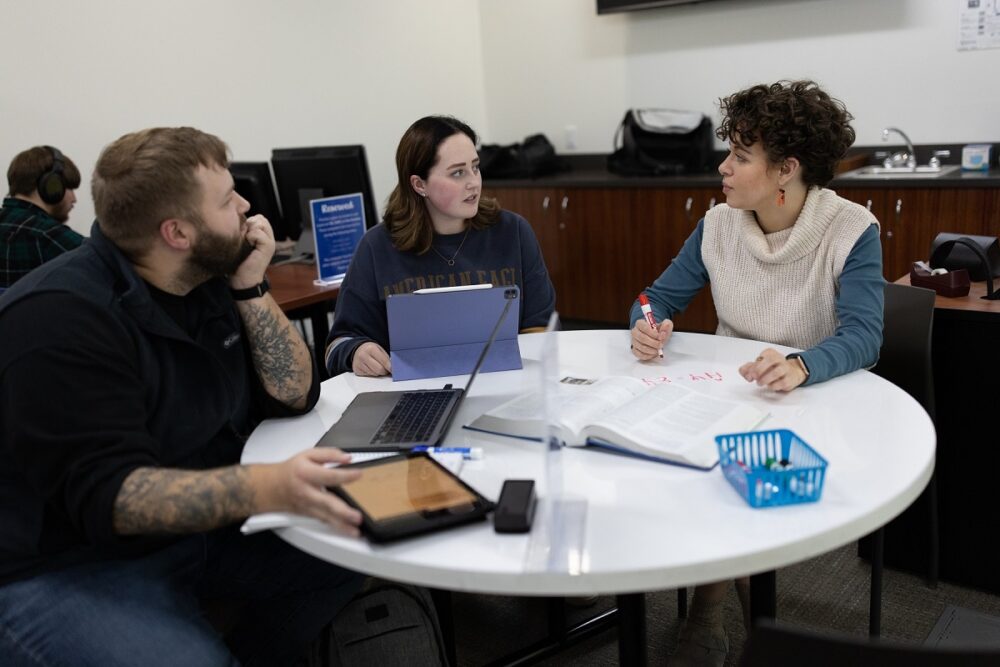
December graduate Chloe Gulbronson worked in biology, chemistry and physics labs while earning her degree in biochemistry at UWSP.
Chloe Gulbronson is intrigued by biochemistry and the molecular mechanics of disease.
Her father’s profession, physical therapy, and a disease diagnosis triggered her interest at a young age. “I’m fascinated by the human body,” said Gulbronson, Wautoma. When she was age 10, her dad was diagnosed with cancer. After observing his care team, she decided to become a doctor. By age 16, she was working as a certified nursing assistant.
When she came to UW-Stevens Point – the only other college to which she applied was in the United Arab Emirates –she learned she also loved research. UWSP has provided many opportunities.
She learned much about research in Chemistry Professor Nate Bowling’s organic chemistry lab. She did organic synthesis of never-before-made turnstile molecules through a series of reactions. Starting a reaction, purifying it and isolating it repeatedly — and failing repeatedly — was a tough, important lesson about research, she said. “I made me think more critically than I ever thought.”
Gulbronson was also captivated by Assistant Professor of Biology Michael Steury’s research on immunology, molecular biology and biochemistry of inflammatory bowel disease. “I was really annoying and persistent to work in his lab,” she said. She began in fall 2021, daily monitoring mice induced with colitis, to establish a connection between the gut and the brain in the disease.
“I was able to use my knowledge from one project to help me with the other,” she said.
Biochemistry combines the knowledge of biology and chemistry to explain life processes in terms of molecular structure and chemical reactions within living cells. Biochemists seek to understand diversity in the principles of chemistry and physics, as well as in the structure, mechanisms and chemical processes common to all organisms.
Perhaps it’s not surprising that Gulbronson was also drawn to a physics lab run by Professor Palesh Banerjee. “An exemplary student, Chloe brought a consistently thoughtful and analytical approach to the physics research lab,” he said. “Her technical and scientific skills at the interdisciplinary interface between biochemistry and experimental physics allowed her to construct a unique instrument studying photon fluctuations from organic dye molecules.”
Three independent research projects at the same time were a bit overwhelming, Gulbronson said. But she felt like she was making up for lab time lost during the pandemic.

Chloe Gulbronson (right) served as a tutor for chemistry, biology, physics and math and also mentored tutors while pursuing her degree at UW-Stevens Point. Here, she’s with students Mitchell Imlan and Josie Voigt in the Chemistry Biology Building drop-in tutoring lab.
Few undergraduate students get the broad research experiences she has had at UW-Stevens Point. “The fact that I had the opportunity to be part of three labs, it’s unheard of at other universities,” Gulbronson said
This was confirmed by peers from Vanderbilt and Columbia universities with whom she participated in an undergraduate research project at Mayo Clinic last summer.
Their Mayo research focused on a protein linked to a pathogenic source of COVID-19. People with high concentrations of this protein in their blood tend to have more severe symptoms during a COVID-19 infection. She investigated how the different variants of the virus, such as the Delta variant, have different mutations in this protein that may correlate to their disease severity. In the future, this research will help assess the virulence of future SARS-CoV-2 strains and how different people will respond to these strains.
Steury introduced her to MD-PhD programs, a double doctoral program that combines research and patient care at institutions such as Mayo and UW Health. That became her new goal, even though the path is long – eight more years of higher education.
“Chloe approached research with enthusiasm and dove into new experiences and opportunities as a chance to develop new skills and explore new techniques,” Steury said. “She demonstrated resiliency when things didn’t go as expected and was quick to offer solutions. The determination and willingness to attempt things unfamiliar to her will continue to provide her opportunities past UWSP and help her succeed in whatever comes next.”
Gulbronson is driven by the need. “There’s a lot of work to be done in the health care system, and it needs people willing to put in the work,” she said.
An honors student, she graduated Dec. 17 in 3.5 years with a 3.97 grade point average. She hopes to do biomedical research before applying to MD-PhD programs.
While research is a big part of her university experience, she also has been a STEM tutor and involved in the Student Government Association. As the Health Service student director during the pandemic, she had opportunities to encourage vaccines and counter misinformation. As SGA inclusivity director, she was involved in revising the university’s Indigenous Land Acknowledgement statement, setting guidelines for when the statement will be read at campus events and other steps to support tribal nations.
“This is a great campus. I met wonderful people. I could not have done half the things I’ve done if I’d gone to a bigger university,” she said.
Written by UW-Stevens Point
Link to original story: https://www.uwsp.edu/news/chloe-gulbronson-dec-grad-2022/
